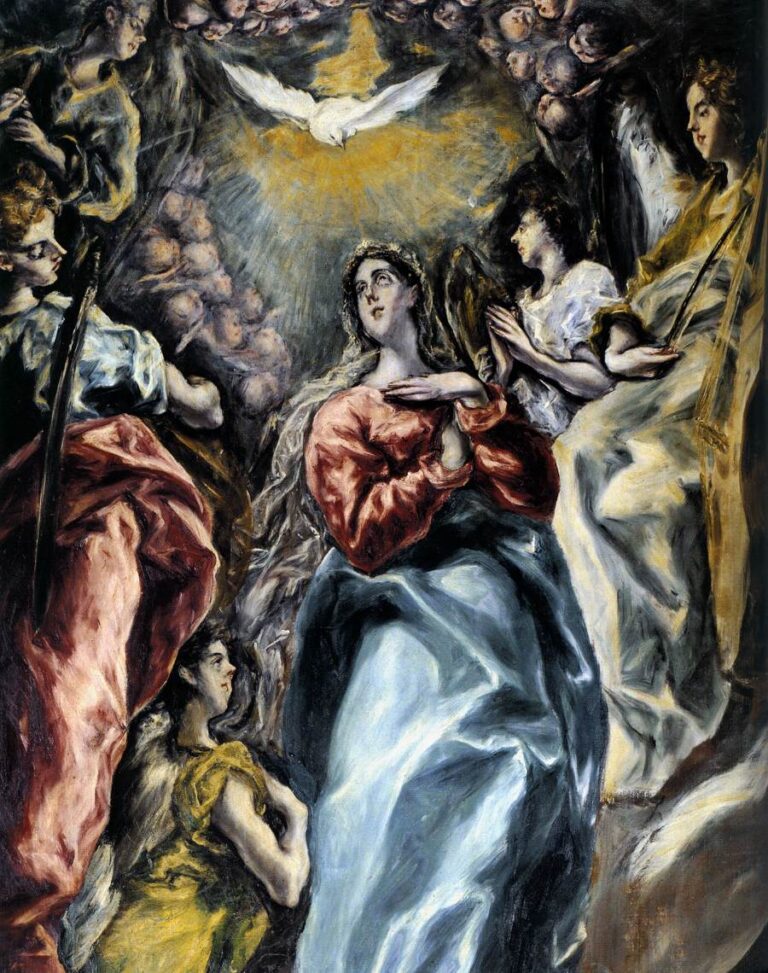8th May 2021
The Immaculate Conception
Adam Coates
We began the first post in this series by talking about the Annunciation; and this is precisely where we will begin when talking about the dogma of the Immaculate Conception.
Let us remind ourselves of what happens at the Annunciation: The Angel Gabriel comes to Mary and tells her she will bear in her womb the Saviour. Mary makes her “yes” and the Second Person of the Blessed Trinity takes flesh and assumes a human nature. This flesh is taken from Mary just as the flesh of you who are reading this is taken from your mother and father.
Now, of His nature, Christ is sinless but he is truly possessing of a human nature. The Second Vatican Council’s Gaudium et Spes declares, “born of the Virgin Mary, He has truly been made one of us, like us in all things except sin”. If Christ, then, truly takes His humanity from the Blessed Virgin Mary, it necessarily leads one to ask how is this possible if she is a sinful human being. The answer lies within the Immaculate Conception. What, however, does this mean precisely?
To put it simply, it means that the Blessed Virgin was conceived, by “a singular grace and privilege of Almighty God”, free from the stain of original sin. Consequently, she never sinned during her time on Earth. How do we know this, however? The answers, implicitly, are found in Sacred Scripture. Returning to the Annunciation narrative, Mary is addressed by the Angel Gabriel by the title “full of grace” (Luke 1:28) – she is filled up with the gifts of God. Secondly, Pope Benedict XVI explicitly links the words of the Angel Gabriel to Mary with the prophecy of Zephaniah which states that “the King of Israel, the LORD, is in your midst”. (Zephaniah 3:15). Pope Benedict explains that this prophecy literally means that the Lord “is in your womb”. He further explains that this is a direct reference to God dwelling among His people in the Ark of the Covenant as first seen in the book of Exodus (Exodus 25:10-22). The Ark of the Covenant is truly special and holy, not to be approached by simply anyone. The Ark of the Old Covenant held the word of God inscribed on stone tablets, the rod of Aaron that bloomed into life (Numbers 17:1-12), and manna, the bread from heaven. The Ark of the New Covenant held Jesus, the Word of God, Jesus who rose on the third day, and Jesus who declared Himself the Bread of Life which had come down from heaven. Mary is revealed as the pure, undefiled bearer of the God Who is with His people. She is made spotless so she might hold Him who is the spotless one.
Some people, in questioning this dogma of the Church, have asked how Mary can be free from sin when, in the Magnificat, she refers to God as her saviour. This is easily answered. In defining the dogma, Pope Pius IX made clear that the “singular grace” given by God is made possible “in view of the merits of Jesus Christ”; that is to say, the merits of the Cross, of the Sacrifice of Calvary, are seen by God dwelling beyond time who then applies them to Mary at her conception. This grace, too, is not simply for her own benefit, but because it has an essential place in God’s divine plan of Salvation.
The Second Vatican Council’s Lumen Gentium says that she was “enriched by God with the gifts which befit such a role”. This gift, this preservation from the stain of original sin enables Mary to make her “yes” at the Annunciation”, to endure the journey to Bethlehem, to stand at the foot of the Cross. In this, Mary is the model of all Christians, an idea we will explore in the next post.
Further reading
- Bl. John Duns Scotus: On the Fittingness of the Immaculate Conception
- Lumen Gentium, 56
- Gaudium et Spes, 22
- Pope Pius IX, Ineffabilis Deus
- Catechism of the Catholic Church: 490 – 493
- Joseph Ratzinger, Jesus of Nazareth: The Infancy Narrative, (Bloomsbury, 2012), pp. 27-28

